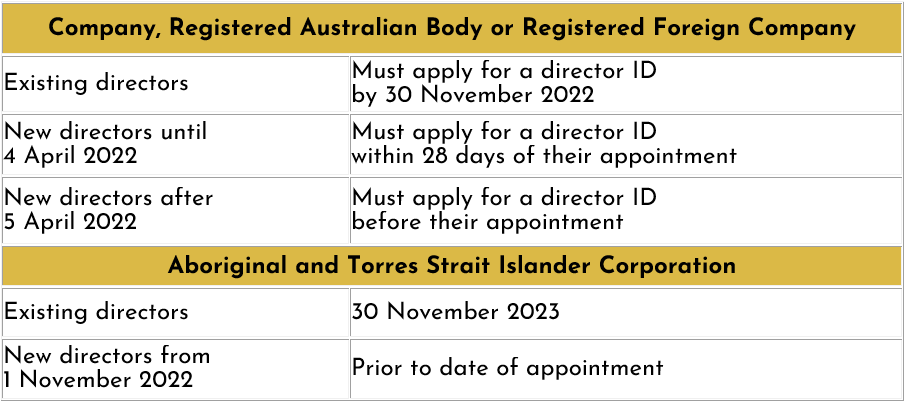What It Is
On 1 November 2021, the Australian Business Registry Services (ABRS) introduced a requirement for directors of relevant companies to obtain a Director Identification Number (Director ID).
A Director ID is a unique, fifteen-digit identifier given to a director of a company who has completed an application and verified their identify with the ABRS.
A director must personally apply for their own Director ID (and it is is free to apply) and will only ever have one Director ID, regardless of how many companies or similar entities they are a director of.
Who It Applies To
Any person who is currently appointed as a director or alternate director of a company, registered Australian body, registered foreign company or Aboriginal and Torres Strait Islander corporation must apply for a Director ID.
You can apply for a Director ID even if you are not currently a director, and it will stay with you for life and can be used if you do ever become a director.
When You Need It
The below table provided by the ABRS succinctly sets out the timeframes for application for a Director ID:

How To Apply
All Directors must make their own applications – unlike other arrangements for company documents your accountant or registered tax agent is not permitted to do this for you.
In order to apply for your Director ID, you will need to go to the ABRS Website and follow the process to download the myGovID app (this is different to myGov). The direct link is Apply for your director ID | Australian Business Registry Services (ABRS).
As part of the application process, you will need to complete a verification of identity, so before you apply you should gather the following information/documents:
- your tax file number (TFN);
- your residential address as held by the ATO; and
- information from two (2) documents to verify your identity – the relevant documents that ABRS suggest are:
- bank account details;
- an ATO notice of assessment;
- superannuation account details;
- a dividend statement;
- a Centrelink payment summary; or
- a PAYG payment summary.
If you are unable to apply online, you can apply by phone or by paper form, but you will still need the above information / documentation.
How Enterprise Legal Can Help
Although we are unable to complete the application for you, we are available to assist you with any questions or concerns you have regarding the Director ID, including whether it applies to you, when you need to make an application by, and any questions about how the application works or the best application method for you.
Contact Enterprise Legal's expert Business Law team today:
☎️ | (07) 4646 2621
✉️ | Submit an Online Request